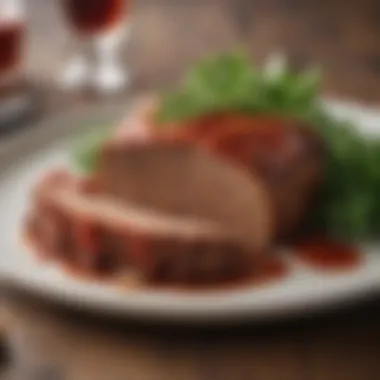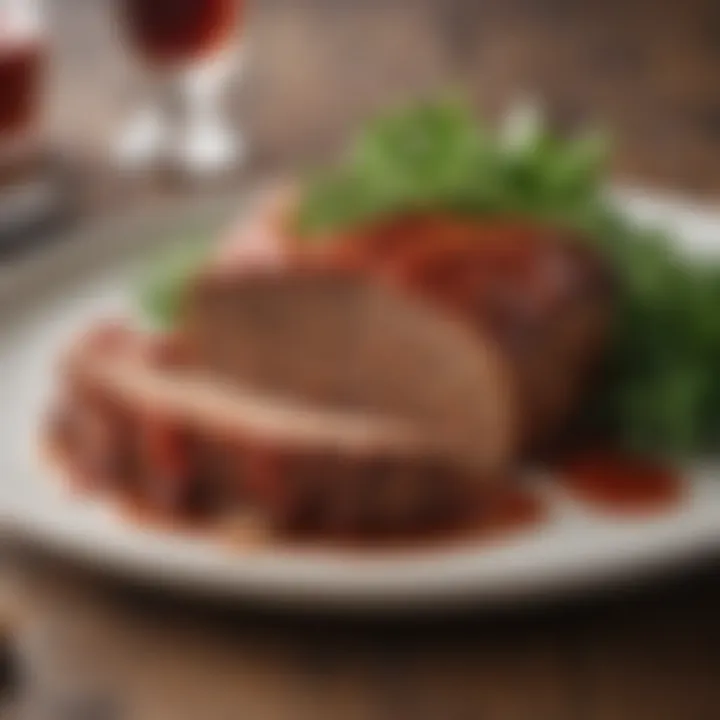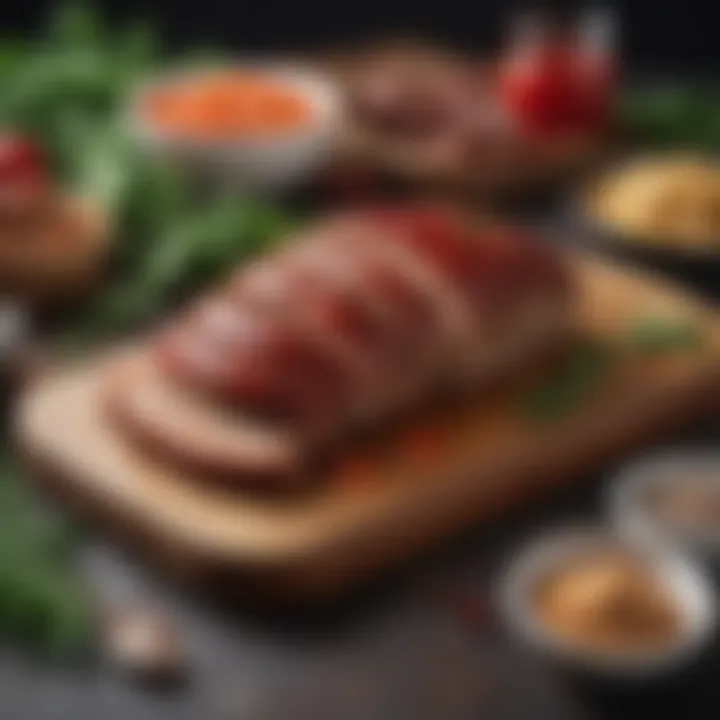Mastering Meatloaf: A Culinary Guide


Intro
Meatloaf is more than just a simple dish; it embodies a tradition of home cooking that resonates with many. Often associated with comfort food, it has evolved through time, taking on various forms and flavors. The goal of this guide is to break down the elements that contribute to making an exceptional meatloaf, catered to your taste and preferences. Understanding its history, ingredient selection, and preparation techniques will help refine your skills in the kitchen.
Recipe Overview
Recipe name
Classic Meatloaf
Brief description of the dish
Classic Meatloaf is a savory dish made primarily from ground meat combined with various ingredients. The mixture is shaped into a loaf and baked, resulting in a hearty and flavorful entrée. It often serves as a family staple, offering versatility in flavors and ingredients.
Ingredients List
Main ingredients
- Ground beef or a mix of ground meats such as pork and veal
- Onion, finely chopped
- Breadcrumbs or oats
- Eggs
- Milk or broth
- Worcestershire sauce
- Salt and pepper to taste
Optional ingredients
- Bell peppers, finely diced
- Garlic, minced
- Dried herbs like thyme or parsley
- Parmesan cheese
- Tomato sauce or ketchup for glazing
By thoughtfully selecting and balancing these ingredients, one can create a meatloaf that is not only enjoyable but also reflects personal preferences in flavor and texture.
Intro to Meatloaf
Meatloaf, a dish often categorized as comfort food, has a place not only in homes but also in history and culture. Its importance lies in its versatility and accessibility. As a well-known staple, meatloaf serves as a canvas for diverse flavors and ingredients. Understanding meatloaf through its historical and cultural lenses can deepen one's appreciation for this beloved dish, while also guiding cooks to create their own version.
Historical Significance
The origins of meatloaf date back to ancient times, with evidence of meat combined with other ingredients for better flavor and sustenance.
Cooks in various eras created their own variations based on what was available. For instance, medieval European dishes often featured minced meat shaped into loaves. These creations laid the groundwork for what we know today as meatloaf. Due to its economical nature and the ability to stretch ingredients, meatloaf became an integral part of American households during the Great Depression. It has since evolved, with many families passing down their own recipes, often loaded with personal stories and memories.
"The history of meatloaf reflects societal changes and economic situations, demonstrating how cuisine adapts over time."
Cultural Variations
Meatloaf is not a one-size-fits-all dish. Different cultures have put their own spin on this comfort food, creating unique variations that showcase local ingredients and preferences.
For example, in Italy, meatloaf may be flavored with rich herbs and served with marinara sauce, adding a distinct Mediterranean flair. Similarly, in Mexico, the dish can be infused with spices like cumin and served with a side of savory beans, transforming it into a spicy delight. Many Asian countries also have their unique recipes, incorporating varied seasonings and cooking techniques.
Both the historical and cultural aspects of meatloaf enhance the understanding and appreciation of the dish. This dish's ability to evolve while remaining familiar makes it a fascinating subject for culinary enthusiasts.
Fundamentals of an Ideal Meatloaf
The fundamentals of an ideal meatloaf serve as the backbone of crafting this classic dish. Understanding these principles can vastly enhance the overall experience, from preparation to flavor satisfaction. Key elements include the selection of essential ingredients, having appropriate tools, and mastering the techniques that yield the best results. Ignoring these fundamentals can result in a lackluster meatloaf that does not fulfill its potential.
Essential Ingredients
Meat Choices
The choice of meat is crucial in meatloaf. The most common meats used are ground beef, pork, chicken, and turkey. Each has its distinct flavor profile and fat content. Beef is often favored for its richness and depth, while turkey offers a lighter option. The fat content in meats affects moisture retention during cooking, which is vital for texture. For instance, ground chuck is popular as it balances flavor and fat effectively, ensuring a juicy result.
However, when using lean meats like turkey, consider blending with pork for moisture. This blend can lead to a delightfully tender meatloaf that retains flavors well.
Binding Agents
Binding agents are essential for holding the meatloaf together. These typically include breadcrumbs, eggs, and even oats. The main role is to absorb moisture and create structure. For instance, breadcrumbs can add texture and help to maintain the moisture of the meat. They are also economical, as they allow you to stretch the meat further.
Some may opt for oats, which can provide a unique texture and added nutritional value. However, one must be cautious with the quantity; too much can lead to a dry or crumbly texture, which can ruin the final product.
Flavor Enhancers
Flavor enhancers bring life to the dish. This can include spices, herbs, vegetables like onion and garlic, and sauces like Worcestershire. Herbs such as parsley or thyme can provide freshness, while onions add natural sweetness. These enhancements are critical, as they allow customization and complexity in flavors. While essential for traditional recipes, they also provide opportunities to explore global influences, like adding cumin for a unique twist. Therefore, using quality flavor enhancers will significantly elevate your meatloaf.
Choosing the Right Tools
Mixing Bowls
The choice of mixing bowl is often overlooked but is significant for efficiency. A sturdy, medium to large bowl allows for thorough mixing without overflow. Materials like glass or stainless steel are beneficial as they are durable and easy to clean. Quite simply, a good mixing bowl will withstand vigorous mixing, ensuring that all ingredients integrate well.
Loaf Pans
The right loaf pan can influence presentation and cooking time. Metal pans conduct heat better, providing a desirable crust, while glass pans allow you to monitor the loaf during baking. Choosing a pan that retains shape and heat is essential to avoid a dense or unevenly cooked loaf. A standard 9x5 inch loaf pan is generally a solid choice, as it accommodates a classic meatloaf size well, enabling even cooking.


Thermometers
Precision in cooking is vital for meatloaf, and thermometers play a key role. A good meat thermometer ensures that the internal temperature reaches a safe level, preventing undercooked or dry meatloaf. Digital thermometers provide quick and accurate readings, which are easier to read than dial types. This prevents the frustration of cutting into a loaf that is not fully cooked, making thermometers an invaluable tool in crafting a perfect meatloaf.
Preparation Techniques
In the realm of meatloaf crafting, Preparation Techniques are essential. These methods directly influence the final texture, flavor, and presentation of the dish. Understanding how to combine and shape ingredients can lead to an exceptional meatloaf that delights the palate. Proper techniques ensure that every element works in harmony, contributing to an enjoyable dining experience.
Combining Ingredients
Layering Flavors
Layering flavors is a critical aspect in creating a meatloaf that stands out. This approach involves adding ingredients in stages throughout the mixing process. By introducing various components at different times, you enhance the overall taste profile. For example, integrating aromatic herbs and spices early can allow their essence to permeate the meat, while adding more delicate ingredients later preserves their integrity. This method is beneficial because it provides a richer, more complex flavor. Using layering can also prevent certain flavors from becoming overshadowed.
Advantages of layering include:
- Enhanced flavor complexity.
- Better balance of tastes.
- Preservation of delicate herbs and spices.
However, careful consideration is necessary. Overdoing the layering can lead to competing flavors which may confuse the palate.
Prevent Overmixing
Preventing overmixing is crucial for maintaining the desired texture of your meatloaf. When ingredients are combined, the goal is to blend sufficiently without breaking down the meat fibers too much. Overmixing can result in a dense loaf that lacks the tenderness that is desirable in a moist meatloaf. A key characteristic of this technique is to mix just until the ingredients are combined and uniform in appearance. This method is popular because it helps retain the juiciness of the meat and creates a more appealing mouthfeel.
Unique features of preventing overmixing include:
- Retaining moisture in the meatloaf.
- Achieving a desirable crumb structure.
Nevertheless, a cautious approach is needed. If not mixed enough, the meatloaf may have an uneven texture or lumps.
Shaping the Loaf
Shaping the meatloaf correctly is fundamental to ensure even cooking and proper presentation. Different techniques contribute significantly to how the meatloaf performs in the oven.
Uniform Size
Uniform size is a crucial aspect when shaping your meatloaf. When the mixture is formed into a consistent shape and size, it cooks more evenly. This is beneficial as it reduces the risk of overcooking some parts while leaving others raw. A key characteristic of uniformity is simplicity; all parts become harmonized in cooking times and thermal gradients.
Advantages of maintaining a uniform size include:
- Even cooking throughout.
- Improved presentation.
On the downside, it may be tempting to rush this step, which can lead to uneven shapes that compromise cooking outcomes.
Surface Area Considerations
Surface area considerations are equally important in the shaping process. The shape of the meatloaf affects the cooking time and browning. A greater surface area can enhance caramelization and flavor development. This consideration entails understanding how the shape influences heat distribution during baking.
One major characteristic is that wider loaves tend to have a better crust due to more exposed surface areas, while taller ones may require extended cooking time.
While there are many methods to form the loaf, keep in mind that altering shape may lead to inconsistent results if not approached thoughtfully.
Cooking Techniques
Cooking techniques play an essential role in creating a meatloaf that not only satisfies the palate but also meets the expectations concerning texture and flavor. Understanding the difference between baking and grilling, as well as how to manage temperature effectively, influences the final outcome significantly. This section will explore these techniques in detail, guiding you through their benefits and considerations, ensuring your meatloaf is prepared to perfection.
Baking vs. Grilling
Advantages of Baking
Baking is the most common method used for meatloaf. One specific aspect of baking is the even heat distribution. This characteristic contributes to cooking the meatloaf uniformly, thus eliminating the risk of undercooked sections. Furthermore, baked meatloaf tends to remain moist, allowing flavors to meld together beautifully. This technique is popular due to the simplicity it offers; all you need is a loaf pan and an oven. A unique feature of baking is that it allows for a consistent cooking environment. However, one disadvantage is that baking may not create caramelized crusts like grilling does, which some cooks might find less appealing.
Flavor Benefits of Grilling
Grilling offers undeniable flavor benefits. The specific aspect of open flame introduces a charred quality that enhances the taste profile. This method is particularly beneficial for those seeking a smoky flavor in their meatloaf. The key characteristic of grilling is that it cooks the meatloaf at a high temperature for a shorter duration, which contributes to a different texture. This method can create a delightful crust on the outside while keeping the interior juicy. A unique feature of grilling is the ability to experiment with wood chips, adding different layers of flavor. However, grilling requires more attention. If not monitored closely, grilling can lead to overcooking or charring, which may compromise the meatloaf’s juiciness.
Temperature Control
Recommended Internal Temperatures
Temperature control is critical for achieving a safe and delicious meatloaf. The recommended internal temperature for meatloaf is generally around 160°F (71°C). This temperature ensures that harmful bacteria are eliminated, making the dish safe to eat. The importance of reaching the proper temperature cannot be overstated, as both undercooked and overcooked meatloaf have their risks. Achieving this ideal temperature allows for a tender texture that is still holding its shape. However, maintaining this temperature requires an understanding of your cooking method, whether it’s baking or grilling.
Resting Period Importance
The resting period after cooking is often overlooked, yet it holds substantial significance. After removing the meatloaf from the heat source, allowing it to rest for about 10-15 minutes lets the juices redistribute throughout the loaf. This characteristic of resting enhances the overall flavor and texture, making each slice more enjoyable. Additionally, the importance of this period lies in preventing the meatloaf from falling apart when cut. A unique feature of resting is that it can improve the juiciness of the meatloaf while also allowing flavors to settle in. On the downside, some may be tempted to skip this step for immediate serving; however, patience results in a much better eating experience.
Flavor Profiles and Enhancements


Flavor profiles and enhancements are crucial to the art of crafting an exceptional meatloaf. The right flavors can transform a simple dish into a gourmet experience. Each ingredient contributes to the overall taste, aroma, and texture. Understanding how spices, herbs, toppings, and glazes work together helps elevate meatloaf beyond simple comfort food. Therefore, choosing the correct flavor combinations is essential for culinary success.
Spice and Herb Selection
Traditional Spices
Traditional spices play an integral role in flavoring meatloaf. They are familiar and comforting, contributing to the dish's classic appeal. Common examples include salt, pepper, garlic powder, onion powder, and paprika. These spices enhance the meat's natural flavor while adding depth.
The key characteristic of traditional spices is their accessibility and ease of use. Most home cooks are familiar with these staples, making them a beneficial choice for any meatloaf recipe. Their unique feature lies in their ability to harmonize well with a variety of meats, ensuring a balanced taste profile.
While traditional spices are widely accepted, they can sometimes lack complexity. Cooks may need to combine them with other ingredients to achieve a more layered flavor.
Global Influences
Global influences can introduce diverse flavors to meatloaf, broadening its appeal. Ingredients such as cumin, coriander, and chili powder can provide a unique twist. Exploring global spices is an exciting way to experiment with traditional recipes and create new variations.
The key characteristic of global influences is their ability to transport flavors from different cultures. They are a popular choice for those seeking unique culinary experiences. This adds an element of creativity to the meatloaf without compromising its essence.
However, incorporating global influences can risk overwhelming the dish if not balanced well. It is important for cooks to understand the basic flavor profiles before venturing into new territory.
Toppings and Glazes
Classic Ketchup
Classic ketchup is a time-honored topping for meatloaf. It is used by many cooks not only for its taste but also for its appealing appearance. Ketchup adds sweetness and acidity, enhancing the flavor of the meat while keeping it moist.
The key characteristic of classic ketchup is its versatility. It complements various flavor profiles and works well as a glaze. The unique feature is its rich red color, providing visual appeal to the dish.
While ketchup is beloved, it can be overly sweet for some. Using it alongside other toppings can create a more balanced flavor.
Alternate Glazes
Alternate glazes, such as barbecue sauce, teriyaki sauce, or even a balsamic reduction, offer exciting possibilities for meatloaf. They can significantly change the dish's flavor profile and allow cooks to showcase their creativity.
The key characteristic of alternate glazes is their ability to blend flavors from different cuisines. They are a beneficial choice for those looking to innovate while still embracing tradition. The unique aspect of using alternate glazes is the potential to elevate the dish’s flavor complexity.
However, caution is needed. Using too strong of a glaze can overshadow the fundamental flavors of the meatloaf itself. Experimentation should be balanced with foundational knowledge to achieve the desired taste.
Serving Suggestions
Serving suggestions play a crucial role in maximizing the enjoyment of meatloaf. They not only enhance the dish's presentation but also affect flavor dynamics and nutritional balance. How you serve your meatloaf can elevate a simple meal into a remarkable dining experience. It encourages creativity and allows varying culinary traditions to shine through, making it adaptable to different occasions.
Accompaniments
Vegetable Pairings
Vegetable pairings add vitality and a burst of flavor to meatloaf. They help to balance the richness of the meat while contributing essential nutrients. Popular choices include roasted carrots, green beans, or steamed broccoli. These vegetables not only provide contrasting textures but also present a color palette that makes a dish more visually appealing.
In meatloaf, the addition of vegetables can enhance flavor and texture. This is especially true when vegetables are incorporated directly into the meatloaf mixture. For example, finely chopped onions or bell peppers contribute moisture and sweetness. However, one must be cautious; too much moisture can lead to a soggy texture. Thus, the incorporation should be balanced and well-measured.
Starches and Sauces
Including starches and sauces is essential for a complete meal experience. Starches like mashed potatoes, rice, or polenta can absorb flavors from the meatloaf, enhancing the overall dish. Mashed potatoes, for instance, are particularly popular due to their creamy texture, which serves as a delightful contrast to the firm meatloaf.
Sauces, such as classic gravy or tangy barbecue, add another layer of flavor. A well-selected sauce can enhance the taste, making each bite more enjoyable. However, it is vital to ensure that the sauce does not overpower the meatloaf’s flavors. The richness of the sauce should complement the meatloaf, not drown it.
Plating and Presentation
Visual Appeal
Visual appeal is a significant aspect of serving meatloaf. It can influence a diner's first impression and overall experience. A well-plated dish can make a hearty meatloaf seem elegant. Simple garnishes like chopped parsley can provide contrast against the meatloaf's brown surface.
Arranging sides in a thoughtful manner can also enhance visual appeal. The colors of vegetables and starches should be considered carefully, ensuring a colorful plate that excites the eye. A well-presented dish can enhance the overall enjoyment and make the meal feel more special.
Serving Atmosphere
The serving atmosphere at meal times is important in setting the mood. Whether it's a formal dinner or a casual gathering, the ambiance can significantly enhance the dining experience. Soft lighting, appealing table settings, and overall decor contribute to how the meatloaf is perceived.
Creating a welcoming atmosphere can make a simple dish feel like a feast. The right ambiance encourages conversation and enjoyment. For example, if the meal is intended as a cozy family dinner, comfort items like cloth napkins and candlesticks can add to the warmth. However, overly elaborate setups may detract from the dish itself, leading to distraction from the meal's flavors.
"Serving suggestions are not just about food; they are about creating an experience that lingers long after the meal is over."
Variations of Meatloaf
Variations of meatloaf are essential to understanding how this dish can adapt to different tastes and dietary needs. The flexibility in recipes showcases the capacity for innovation while respecting traditional methods. By exploring various versions, the cook can identify combinations of ingredients and flavors that appeal to a broader audience. Furthermore, incorporating alternative styles allows for experimentation with new textures and tastes. This section will focus on meat alternatives and regional twists, emphasizing their contribution to creativity in meatloaf preparation.
Meat Alternatives


Vegetarian Versions
Vegetarian versions of meatloaf have risen in popularity due to the increasing interest in plant-based diets. The key characteristic of these meatloafs is the use of vegetables, legumes, grains, and nuts as the main components. Ingredients like lentils, black beans, mushrooms, quinoa, and zucchini can form a hearty base that is nutritious and satisfying.
One significant advantage of vegetarian meatloaf is its lower environmental impact compared to traditional meat-based versions. These alternatives often have fewer calories and can be packed with fiber and vitamins. However, the unique challenge is balancing flavors to ensure that these meatloafs are flavorful without any meat. Utilizing spices, herbs, and various sauces will enhance taste and give depth to the dish.
Vegan Adaptations
Vegan adaptations take vegetarian meatloaf a step further by eliminating all animal products. This approach emphasizes fruits, vegetables, beans, and substitutes such as tempeh, tofu, or chickpeas. A distinctive feature of vegan meatloaf is often a binding agent like flaxseed or aquafaba, providing structure without eggs.
The popularity of vegan meatloaf has grown as more individuals seek plant-based meals for health and animal welfare reasons. One advantage is accessibility to a wider audience who may have dietary restrictions. Nonetheless, developing a satisfying taste remains a key focus, and some may find vegan meatloaf lacking in flavor. By incorporating bold spices and sauces, cooks can enhance their dishes significantly.
Regional Twists
Mexican-Inspired Meatloaf
Mexican-inspired meatloaf brings an exciting twist to the traditional dish by integrating flavorful ingredients like salsa, corn, and cumin. One of its key characteristics is the infusion of spices familiar with Mexican cuisine, such as chili powder and jalapeños. This provides an exciting depth of flavor while introducing new textures to the classic meatloaf.
The benefit of a Mexican-inspired version lies in its ability to create a more vibrant dining experience. It appeals to those who appreciate bold tastes and imagery associated with Mexican culture. However, one must be cautious about balancing the spice levels to ensure it is neither too overpowering nor too bland.
Italian Flavors
Italian flavors in meatloaf incorporate ingredients like marinara sauce, mozzarella cheese, and Italian herbs such as basil and oregano. This style highlights the importance of traditional Italian cooking methods and flavor profiles. The addition of parmesan can also enhance the richness of the meatloaf.
One advantage of Italian meatloaf is its versatility; it can be served with spaghetti or used in sandwiches. This version caters well to diners who enjoy comfort food with a sophisticated twist. However, the challenge is maintaining moisture without making it soggy, as the tomato-based components can introduce excess liquid.
In summary, variations of meatloaf provide opportunities for creativity, enabling cooks to cater to diverse preferences and dietary needs. Each adaptation brings its own strengths and weaknesses, contributing to the evolving landscape of this beloved dish.
Common Mistakes and Solutions
Understanding common mistakes in meatloaf preparation is vital. Each step in crafting a meatloaf can lead to pitfalls that affect the final result. By identifying these mistakes and knowing how to correct them, cooks can enhance the texture, flavor, and overall quality of their dish. Learning about these issues not only improves culinary skills but also builds confidence in the kitchen. Here, we will discuss the specific elements that contribute to these mistakes and offer solutions to elevate your meatloaf making.
Understanding Texture Issues
Common Causes
Texture is a critical component of meatloaf. Common causes of texture issues often stem from the selection of ingredients and the preparation process. Overmixing can lead to a dense loaf, while undermixing might result in a crumbly structure. Texture problems arise from using excessive fat or too little binding agent. Both can fundamentally alter the meatloaf's characteristics. A well-balanced mix ensures a tender yet firm consistency. The key characteristic of this section is to emphasize how proper handling during preparation influences the end product.
The unique feature of these common causes lies in how they reflect the importance of each ingredient in achieving the desired outcome. Understanding these causes helps to pinpoint specific areas needing attention when making adjustments in the preparation methods.
Corrective Measures
Knowing how to adopt corrective measures is equally important. If a meatloaf comes out too dense, it may require adjustments in mixing technique or ingredient composition. Reducing mixing time can help maintain tenderness. Corrective measures often emphasize a return to basic principles in cooking, stressing the importance of feeling the mixture rather than strictly following a time-based routine.
The distinct advantage of implementing these measures is the immediate positive effect they have on the texture, ultimately leading to a much more enjoyable meal. Learning these techniques creates a pathway for continuous improvement in baking practices.
Balancing Seasoning
Underseasoned Problems
Underseasoned meatloaf presents a major issue, leading to a bland dish lacking depth. This problem usually arises from not incorporating enough seasoning, herbs, or spices during preparation. It reflects a misunderstanding of how bold flavors elevate a seemingly simple dish. The characteristic of this issue is its widespread occurrence, particularly among novice cooks. An underseasoned meatloaf often has little to offer, missing out on layers of flavor.
The unique feature of identifying underseasoned problems is the potential to transform a dish with just a few adjustments. By becoming aware of this issue, cooks can learn to err on the side of caution by adding spices at different stages of preparation.
Overseasoning Adjustments
Conversely, overseasoning can ruin a meatloaf as well. Too much salt or strong spices can overwhelm the palate and mask the dish’s natural flavors. Overseasoning adjustments are important, as they require a delicate balance between enough flavor and excess. Recognizing this is vital for creating a well-rounded meatloaf.
The unique feature here is the complexity of flavors that must be managed. While seasoning enhances dishes, understanding how to correct overseasoning is crucial. Some adjustments might include adding more meat or a neutral ingredient, such as bread crumbs, to absorb excess flavor, creating a harmonized dish.
Culmination and Final Thoughts
As we come to the end of this comprehensive exploration of meatloaf, it is essential to reflect on the journey we have taken. The topic of crafting an exceptional meatloaf is not just about following a recipe; it involves embracing a culinary tradition while allowing room for creativity and innovation. Each section of this guide has provided vital insights that can transform a simple dish into a remarkable one.
In summarizing, the significance of understanding historical context, ingredient selection, preparation techniques, and variations becomes clear. These elements contribute to both the flavor and texture of the meatloaf. The knowledge accumulated throughout the article empowers cooks at every level to approach meatloaf with confidence and curiosity.
Moreover, as we explore various cultural interpretations and the potential for customization, it becomes evident that meatloaf is a versatile dish that can cater to diverse tastes and dietary needs. By mastering basic techniques and recognizing common pitfalls, one can significantly enhance their culinary repertoire.
"Cooking is not just about following instructions; it’s an art that allows you to express yourself through flavors and aromas."
Recap of Key Points
To summarize the essential points discussed:
- Historical Significance: Understanding the origins of meatloaf provides context and depth.
- Essential Ingredients: Selecting the right meat, binders, and flavor enhancers is crucial for the perfect loaf.
- Preparation Techniques: Proper methods of combining ingredients and shaping the loaf can greatly affect the outcome.
- Cooking Techniques: The choice between baking and grilling affects the taste and texture, while precise temperature control is critical.
- Flavor Profiles and Enhancements: Diverse spices, herbs, and toppings elevate the dish from ordinary to extraordinary.
- Serving Suggestions: Thoughtful accompaniments enhance the overall dining experience.
- Variations of Meatloaf: Including vegetarian and regional twists ensures everyone can enjoy this dish.
- Common Mistakes and Solutions: Awareness of texture issues and seasoning balance helps in achieving the ideal meatloaf.
Encouragement for Experimentation
In the realm of cooking, experimentation can often lead to groundbreaking results. Meatloaf offers a canvas for chefs to express their individuality and creativity. Feel free to modify traditional ingredients, experiment with spices or even introduce unexpected flavors.
Consider trying local ingredients that might enhance your dish or play with texture by adding vegetables or grains. Perhaps you may wish to explore fusion cuisines, combining techniques from different culinary traditions.
Each attempt offers the opportunity to learn about flavors, textures, and personal preferences. Remember, not every experiment will yield a masterpiece, but each effort will contribute to your growth as a cook. So, approach your next meatloaf endeavor with an open mind and a spirit of discovery.







